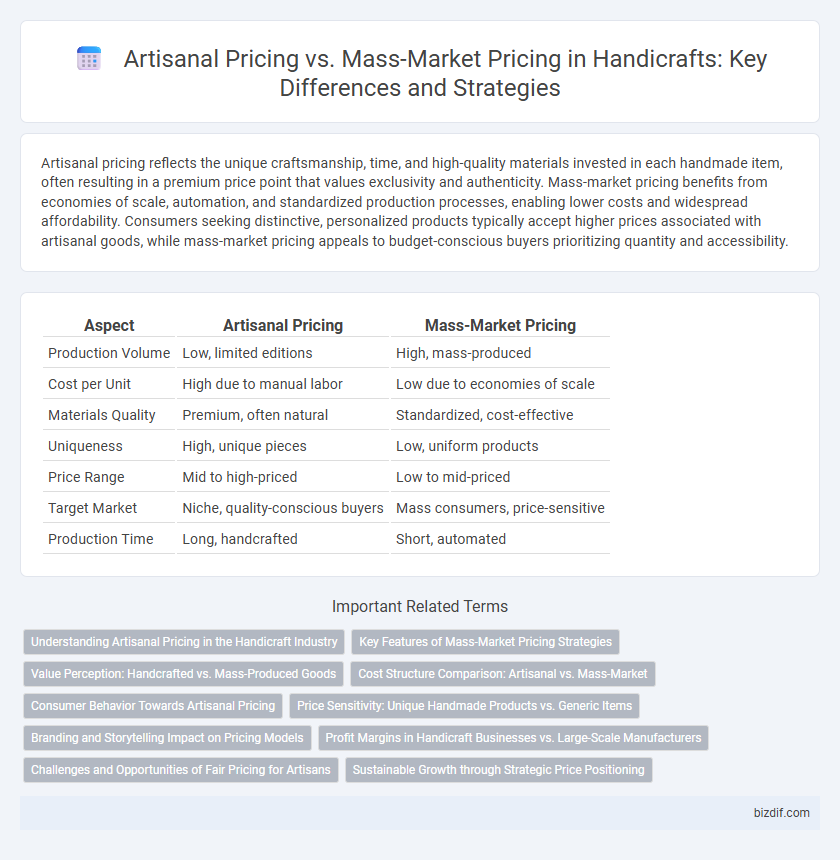Artisanal pricing reflects the unique craftsmanship, time, and high-quality materials invested in each handmade item, often resulting in a premium price point that values exclusivity and authenticity. Mass-market pricing benefits from economies of scale, automation, and standardized production processes, enabling lower costs and widespread affordability. Consumers seeking distinctive, personalized products typically accept higher prices associated with artisanal goods, while mass-market pricing appeals to budget-conscious buyers prioritizing quantity and accessibility.
Table of Comparison
| Aspect | Artisanal Pricing | Mass-Market Pricing |
|---|---|---|
| Production Volume | Low, limited editions | High, mass-produced |
| Cost per Unit | High due to manual labor | Low due to economies of scale |
| Materials Quality | Premium, often natural | Standardized, cost-effective |
| Uniqueness | High, unique pieces | Low, uniform products |
| Price Range | Mid to high-priced | Low to mid-priced |
| Target Market | Niche, quality-conscious buyers | Mass consumers, price-sensitive |
| Production Time | Long, handcrafted | Short, automated |
Understanding Artisanal Pricing in the Handicraft Industry
Artisanal pricing in the handicraft industry reflects the unique craftsmanship, time investment, and high-quality materials used in each piece, distinguishing it from mass-market pricing that relies on economies of scale and lower production costs. Handcrafted items often command premium prices due to limited availability, cultural significance, and personalized details that cannot be replicated in mass production. Understanding these pricing dynamics helps consumers appreciate the intrinsic value embedded in artisanal products, supporting sustainable and ethical purchasing decisions.
Key Features of Mass-Market Pricing Strategies
Mass-market pricing strategies prioritize affordability and volume sales, leveraging economies of scale to reduce production costs and offer lower prices to a broad consumer base. These strategies often involve standardized products, extensive distribution channels, and aggressive promotional campaigns to maximize market penetration. Pricing models typically emphasize competitive pricing, discounts, and psychological pricing techniques to attract price-sensitive customers and drive high turnover rates.
Value Perception: Handcrafted vs. Mass-Produced Goods
Artisanal pricing reflects the unique value perception linked to handcrafted goods, emphasizing exclusivity, craftsmanship, and quality that mass-produced items often lack. Consumers associate higher prices with the authenticity and detailed workmanship inherent in artisanal products, driving willingness to pay a premium. In contrast, mass-market pricing relies on economies of scale and lower production costs, appealing to price-sensitive buyers but offering less perceived uniqueness and personal connection.
Cost Structure Comparison: Artisanal vs. Mass-Market
Artisanal pricing reflects higher production costs due to handcrafted techniques, limited batch sizes, and premium raw materials, resulting in greater labor intensity and unique value. Mass-market pricing benefits from economies of scale, automated processes, and bulk material purchases, significantly reducing unit costs and enabling lower retail prices. This fundamental cost structure difference underscores artisanal products' emphasis on craftsmanship and exclusivity versus mass-market goods' focus on efficiency and affordability.
Consumer Behavior Towards Artisanal Pricing
Consumers often perceive artisanal pricing as a reflection of quality, uniqueness, and craftsmanship, driving a willingness to pay premium prices for handcrafted products. The emotional connection and storytelling behind artisanal goods enhance perceived value, influencing purchasing decisions more than mass-market pricing. Price sensitivity decreases when consumers associate artisanal products with authenticity and exclusivity, fostering brand loyalty and repeat purchases.
Price Sensitivity: Unique Handmade Products vs. Generic Items
Artisanal pricing reflects the unique craftsmanship, limited production, and higher material costs inherent in handmade products, often leading to less price sensitivity among consumers valuing exclusivity and quality. Mass-market pricing targets generic items produced at scale, prioritizing affordability and broad accessibility, which increases consumer price sensitivity due to interchangeable alternatives. The distinct value propositions in artisanal versus mass-market goods fundamentally shape pricing strategies and customer willingness to pay.
Branding and Storytelling Impact on Pricing Models
Artisanal pricing leverages unique branding and storytelling to justify premium prices by emphasizing craftsmanship, cultural heritage, and exclusivity. Mass-market pricing relies on cost efficiency and standardized production, often reducing emotional value and consumer connection. Effective storytelling in artisanal products creates perceived value, enabling higher price points compared to mass-produced counterparts.
Profit Margins in Handicraft Businesses vs. Large-Scale Manufacturers
Handicraft businesses typically exhibit higher profit margins per unit due to the unique, labor-intensive nature of artisanal products, contrasting with the lower margins but higher volume strategy of large-scale manufacturers. Artisanal pricing reflects the value of craftsmanship, limited production runs, and customized designs, justifying premium prices that mass-market products cannot command. While mass-market pricing aims for cost efficiency and competitive pricing through economies of scale, it often sacrifices profit margin per unit in favor of overall market share and volume sales.
Challenges and Opportunities of Fair Pricing for Artisans
Artisanal pricing faces challenges including higher production costs and limited economies of scale compared to mass-market pricing, making fair pricing difficult to sustain while ensuring profitability. Opportunities arise from growing consumer demand for unique, ethically made products, allowing artisans to justify premium pricing and build loyal customer bases. Leveraging transparent storytelling and direct-to-consumer sales channels helps artisans overcome pricing challenges and enhance perceived value.
Sustainable Growth through Strategic Price Positioning
Artisanal pricing reflects the unique craftsmanship and limited production of handmade goods, allowing for higher margins that support sustainable growth by reinvesting in quality and innovation. Mass-market pricing, driven by economies of scale and standardized production, often competes on volume rather than value, risking brand dilution and price wars. Strategic price positioning balances these approaches by emphasizing the authenticity and exclusivity of artisanal products while leveraging market insights to optimize profitability and long-term brand equity.
Artisanal pricing vs Mass-market pricing Infographic

 bizdif.com
bizdif.com